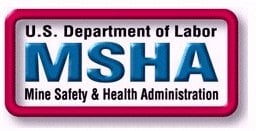As a facility manager, you’ve no doubt heard of the Occupational Safety and Health Administration (OSHA), but if your facility mines or transports mined materials, you also need to pay attention to another key industry regulator: MSHA.
The Mine Safety and Health Administration is just as critical to workplace safety compliance at your facility as OSHA and internal corporate regulations. In fact, the consequences of an MSHA violation could be worse than for an OSHA citation.
Here are the four most common questions (and answers) about MSHA safety compliance and why your facility can’t afford to ignore these serious regulations:
Who Is The Mine Safety & Health Administration?
MSHA was created by the Federal Mine Safety and Health Act in 1977 (seven years after the act that created OSHA). The Act applies to all mining and mineral processing ventures in the U.S. regardless of their size, method of extraction or number of employees. Besides obvious mines and mining operations, MSHA also regulates specific functions in cement processing and transportation (more information in the section below).
According to the law, MSHA is required to inspect surface mines at least twice a year and underground mines at least four times a year (with exceptions for seasonal or intermittent operations).
When Do MSHA Safety Regulations Apply To My Facility?
There is no clear answer on when MSHA safety regulations trump other compliance organizations such as OSHA, the Department of Transportation (DOT) or the Federal Railroad Administration (FRA). With that in mind, your workplace compliance efforts should always strive to exceed whichever organization has the strictest requirements within a given process.
At facilities like cement processing plants (not including concrete), all work inside the plant falls under the jurisdiction of OSHA compliance. However, all cement truck loading processes (including traffic control) fall under MSHA safety regulations. Once the truck is on the road, DOT regulations apply. The same goes for rail car loading at a cement plant: The loading process is covered by MSHA, but the moving cars are regulated by the FRA.
How Does MSHA Differ From OSHA And Other Regulators?
In the U.S., health and safety in mining operations fall under MSHA, OSHA and NIOSH (the National Institute for Occupational Safety and Health). State-level regulations also sometimes apply, but national organizations generally oversee day-to-day practices.
Both MSHA and OSHA have a hierarchy of fall prevention standards they enforce. While they’re both similar, MSHA’s most common standard requires fall protection measures for any work 6 feet (1.83 meters) off the ground. On the other hand, OSHA requires fall protection at 4 feet (1.22 m) for general industry settings, 5 feet (1.52 m) in shipyards, 6 feet (1.83 m) at construction sites and 8 feet (2.44 m) in longshoring operations.
Another key difference between OSHA and MSHA safety compliance is how they cite and fine various violations. In one particular fatality at a limestone mining operation, MSHA charged the facility under section 30 CFR 56.15005, which dictates that safety belts must be worn and a second person should tend the lifeline. In addition, MSHA cited section 30 CFR 56.9100, stating that signs of hazardous conditions should be placed appropriately and that trucks must be spotted correctly. If this same incident had fallen under OSHA jurisdiction, the facility would have only been fined for not providing fall protection, and the truck spotting citation would not have been issued.
Your facility can’t afford to ignore MSHA safety compliance. Rather, you need to invest in the proper safety solutions and personnel training to keep your team safe and efficient – no matter what regulations apply.
Is your work site as safe as it needs to be in order to ensure corporate, OSHA or MSHA compliance? Click below to take this online assessment and discover what safety metrics you need to be tracking for a safer workplace.





